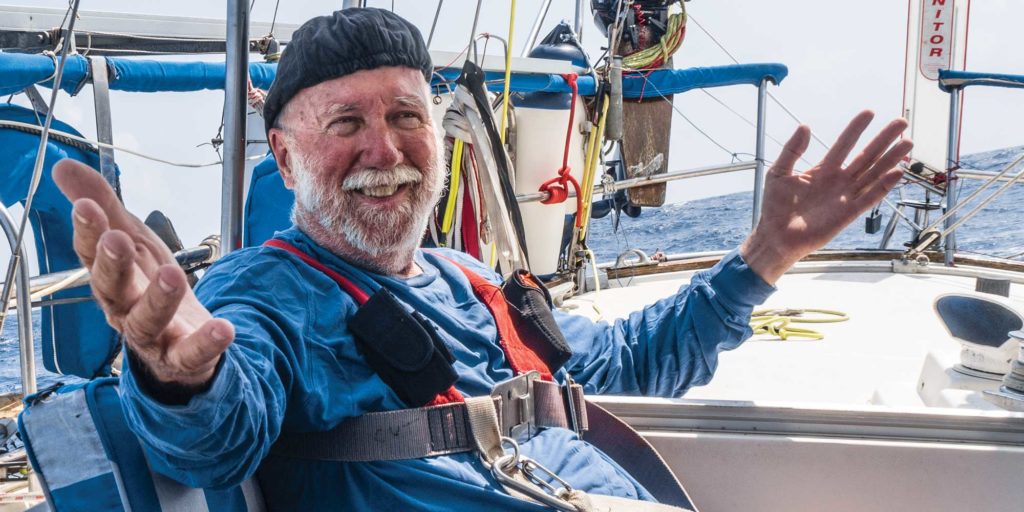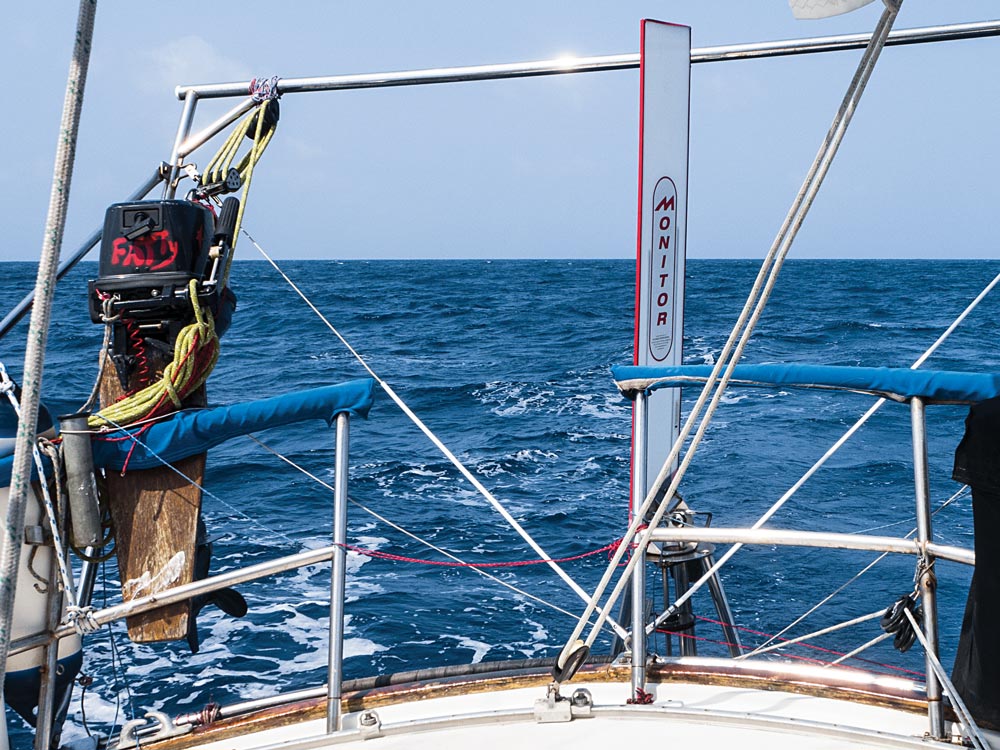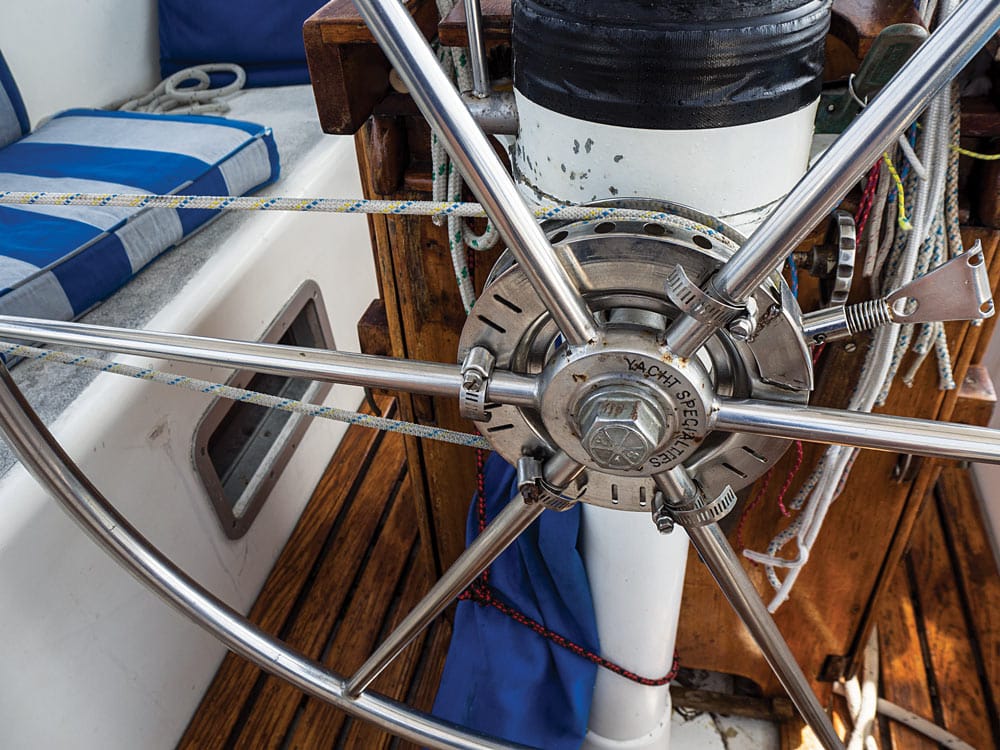
Immediately after completing a 38-day passage from Cape Town, South Africa, to St. John in the U.S. Virgin Islands, I raced on a lovely yawl named Osprey. And I was honored when Larry Best, a highly competitive Virgin Islands racing skipper, allowed me to helm her on the downwind run with the massive chute up.
There is a certain irony here. Larry probably figured my helming skills would be pretty good after such a long downhill South Atlantic passage. I knew, however, that Larry had already steered his vessel, that very day, more than I had hand-steered my cruising sailboat in the past year or two.
The fact is that offshore sailors almost never steer their boats, and with good reason. Steering is fatiguing. If a cruising couple steers their vessel watch-on, watch-off, there is little time for seamanship, navigation or even proper nutrition. That’s why many offshore boats in the 1930s crossed the Atlantic with a crew of five plus a cook. There were three helmsmen to steer continuously; the navigator was free to massage his sextant and chronometer; and the owner/skipper acted as coordinator. (Back in the old days, sea cooks weren’t considered fully human, hence the common nautical curse, “son of a sea cook!”)
In our travels, my wife, Carolyn, and I have met only one circumnavigating couple who steered 24/7 and had no autopilot. The fairer member of that crew hinted darkly about jumping ship.
I believe strongly in not having to constantly hand-steer a sailboat. Joshua Slocum agreed. That’s why he was so proud of Spray’s remarkable ability to steer itself upwind and downwind, a task beyond most modern fin-keel production boats.
But let’s say, for the sake of argument, that you cannot afford an autopilot or windvane, but still want to circumnavigate. OK, then you’ll need an easily balanced boat, the sailing skills to do so and the knowledge to understand basic sheet-to-tiller steering.

First off, most well-mannered sailboats will steer forever to windward with the main slightly under-trimmed and the headsail slightly over-trimmed. Here’s how it works: The over-trimmed headsail forces the bow down, which fills the main and forces the bow up. If done crudely, the boat wildly hunts, but with a little tweaking, a steady (if slightly slower than normal) course results.
When beam-reaching on my 1932 wooden sloop, Corina, balancing the sails often worked the same way in steady winds and smooth-seas conditions. But in the rough stuff, the boat required a shock cord to leeward and the jib sheet led to the windward side and then to the tiller to maintain course in gusts and lulls.
Many a cruising vessel has reached around the world with sheet-to-tiller steering. But it is complicated and requires frequent monitoring and adjustment. Worse, most courses are mainly off the wind, and this method works poorly “dead-down” as we call it.
Enter the “heavenly twins” of yore. Basically, two same-size headsails were set off twin over-length whisker poles in such a manner that the moment the boat got off course, the relaxed sheet would allow the now-straining sheet to yank the tiller back on course. This is, in part, why tillers were so popular in yesteryear. The same effect can be maintained today with a wheel clutch on a well-tracking vessel.
The problem with all of the jury-rigged steering systems isn’t their dependability — such cobbled-together rigs are amazingly robust — but they presuppose a perfectly balanced boat and a skipper willing to play with the sheet-to-tiller concept until mastered. Most cruising sailors today can’t be bothered, and make do with an electric push-button autopilot. These modern units steer the boat quite well under normal conditions, but they require massive amounts of electrical energy. Thus, one problem is exchanged for another.

For example: On our Wauquiez ketch, Ganesh, we have an expensive hydraulic Robertson autopilot that steers quite well even in severe conditions. But we cannot keep it supplied with electrical energy (8 to 12 amps) during gales without cranking up our diesel, despite having an Air X wind generator, seven solar cells and eight deep-cycle batteries.
Our solution is a Monitor windvane, which works well on a properly balanced and designed semi-full-keeled vessel. If Ganesh sails at more than 2.75 knots and the wind is below 40 to 45 knots, our Monitor steers us perfectly, with zero energy requirements.
We even use our Monitor during extreme weather in conjunction with slowing drogues. It is far faster to react, more robust and automatically adjusts to temporary changes of wind direction.
If Ganesh sails at more than 2.75 knots and the wind is below 40 to 45 knots, our Monitor steers us perfectly, with zero energy requirements.
In fact, after three successful circumnavigations with a Monitor on my transom, I personally would not go to sea in a cruising monohull without a dependable self-steering windvane from a trusted manufacturer.
So there you have it. There are four stark choices: 1) spend most of your waking hours chained to the helm; 2) learn the basics of balancing your vessel and using sheet-to-tiller techniques; 3) bear the expense of buying a dependable autopilot and keeping it supplied with electric energy; or 4) buy a servo-pendulum self-steering device that requires no electrical energy.
Far and away, the most popular option is No. 3, which means owners must focus on making their craft a seaborne electrical generation station. We know one boat that is covered with solar cells, has two wind generators and tows a hydro-generator — plus, it employs a large smart alternator with battery-temperature sensing technology.
“No problem!” says its happy skipper, who always carries a quick-draw ohmmeter in the old leather pouch where his rusty rigging knife used to go.
To each his own.
But the ultimate truth I’m attempting to steer you to is this: Happy cruisers and contented offshore marriages live aboard sturdy, well-found vessels that have robust abilities to steer themselves efficiently without human involvement.
A dependable autopilot or the practiced ability to get the vessel to self-steer is a major component of the accomplished ocean-voyaging lifestyle. If a ship’s captain has failed at this all-important goal, he or she has probably failed at the upcoming voyage, they just don’t know it yet.
The positive side of all this is that once you’re freed of the helm, life offshore becomes bliss. You get plenty of rest. You can maintain your vessel. You can monitor your navigation. You can look forward to your exotic destination.
And, best of all, you can focus on what is really important in life: your partner, your mutual pleasure and the vast joy of sailing through God’s own cathedral.
Fatty and Carolyn were in landless Beveridge Reef, finishing up a writing project, while writing this On Watch. Soon, they will steer for New Zealand, while alternating between their Monitor windvane and their electro-hydraulic autopilot.








